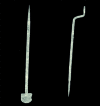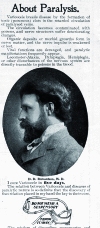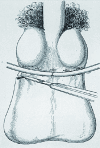The history of varicocele: from antiquity to the modern ERA
- PMID: 29570260
- PMCID: PMC5996787
- DOI: 10.1590/S1677-5538.IBJU.2017.0386
The history of varicocele: from antiquity to the modern ERA
Abstract
Men have most likely been affected by varicocele since the assumption of the upright position. In De Medicina, written during the first century AD, Celsus credits the Greeks with the first description of a varicocele, and he recorded his own acute observation: "The veins are swollen and twisted over the testicle, which becomes smaller". Celsus himself is credited with the distinction between varicocele (dilation of surface veins) and "cirsocele" (dilation of deep veins). There has been a long history of treatment attempts and failures, some of which are remarkably strange, that have sometimes culminated in tragedy, as in the case of French professor Jacques-Mathieu Delpech (1772- 1832). Although some questions regarding the etiopathology and treatment of varicocele remain unanswered, a succession of more or less conservative attempts involving all medical cultures has been performed throughout history. The report by W.S. Tulloch in 1952 brought varicocele into the era of modern evidence-based medicine, and varicocele surgery finally progressed beyond the aim of merely relieving scrotal pain and swelling. From 1970 to 2000, varicocelectomies gained worldwide attention for the treatment of male infertility. Several innovative procedures to correct varicoceles began to appear in the world's literature as interventional radiology, microsurgery, laparoscopy, and robotics, while comprehensive review articles were also published on the subject of varicocelectomies. Microsurgery is nowadays used worldwide and it can be considered to be the gold standard for correcting infertility linked to varicocele.
Keywords: Varicocele; history of medicine.
Copyright® by the International Brazilian Journal of Urology.
Conflict of interest statement
Conflict of interest: None declared.
Figures











Similar articles
-
Varicocele--a historical perspective.World J Urol. 1999 Jun;17(3):151-7. doi: 10.1007/s003450050123. World J Urol. 1999. PMID: 10418088
-
[Infertility and varicocele through history].Arch Esp Urol. 2004 Nov;57(9):876-82. Arch Esp Urol. 2004. PMID: 15624388 Spanish.
-
[Surgical treatment of the lower extremities varicose veins throughout the ages].Przegl Lek. 2007;64(7-8):541-4. Przegl Lek. 2007. PMID: 18409363 Polish.
-
The evolution and refinements of varicocele surgery.Asian J Androl. 2016 Mar-Apr;18(2):171-8. doi: 10.4103/1008-682X.170866. Asian J Androl. 2016. PMID: 26732111 Free PMC article. Review.
-
Evolution of illustrations in anatomy: a study from the classical period in Europe to modern times.Anat Sci Educ. 2015 Mar-Apr;8(2):175-88. doi: 10.1002/ase.1479. Epub 2014 Jul 22. Anat Sci Educ. 2015. PMID: 25053471 Review.
Cited by
-
From pathophysiology to practice: addressing oxidative stress and sperm DNA fragmentation in Varicocele-affected subfertile men.Int Braz J Urol. 2024 Sep-Oct;50(5):530-560. doi: 10.1590/S1677-5538.IBJU.2024.9917. Int Braz J Urol. 2024. PMID: 39106113 Free PMC article. Review.
-
Trends for Surgical Treatment of Testicular Varicocele: A German Whole-population Analysis of Inpatient Procedures from 2006 to 2021.Eur Urol Open Sci. 2025 Mar 28;75:29-36. doi: 10.1016/j.euros.2025.03.001. eCollection 2025 May. Eur Urol Open Sci. 2025. PMID: 40224319 Free PMC article.
-
Surgical or radiological treatment for varicoceles in subfertile men.Cochrane Database Syst Rev. 2021 Apr 23;4(4):CD000479. doi: 10.1002/14651858.CD000479.pub6. Cochrane Database Syst Rev. 2021. PMID: 33890288 Free PMC article.
-
Outcome following the surgical management of varicocele in children and adolescents: a systematic review and meta-analysis.Ther Adv Urol. 2023 Oct 20;15:17562872231206239. doi: 10.1177/17562872231206239. eCollection 2023 Jan-Dec. Ther Adv Urol. 2023. PMID: 37868369 Free PMC article.
-
Development and validation a task-specific checklist for a microsurgical varicocelectomy simulation model.Int Braz J Urol. 2020 Sep-Oct;46(5):796-802. doi: 10.1590/S1677-5538.IBJU.2019.0571. Int Braz J Urol. 2020. PMID: 32539251 Free PMC article.
References
-
- Saber A. Ancient Egyptian surgical heritage. J Invest Surg. 2010;23:327–334. - PubMed
-
- Shokeir AA, Hussein MI. The urology of Pharaonic Egypt. BJU Int. 1999;84:755–761. - PubMed
-
- Bonafini B, Pozzilli P. Scrotal asymmetry, varicocoele and the Riace Bronzes. Int J Androl. 2012;35:181–182. - PubMed
-
- Hotchkiss RS. Infertility in the male. In: Campbell MF, Harrison JH, editors. Urology. Saunders; Philadelphia, USA: 1970. pp. 674–674.
-
- Aulus Cornelius Celsus über die arzneiwissenschaft in achtbüchern; übersetzt und erklärt von Eduard Scheller. Braunschweig, F. Vieweg und sohn; 1906.
Publication types
MeSH terms
LinkOut - more resources
Full Text Sources
Other Literature Sources
